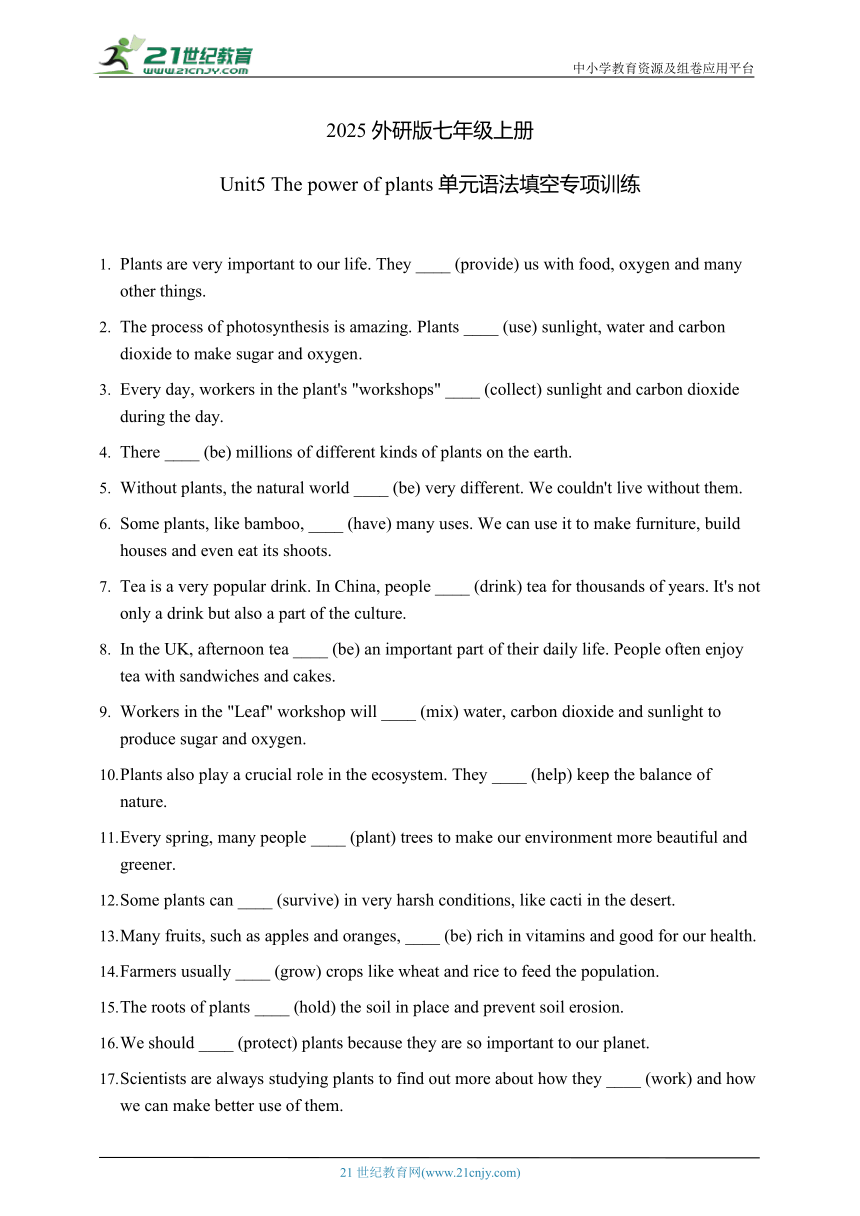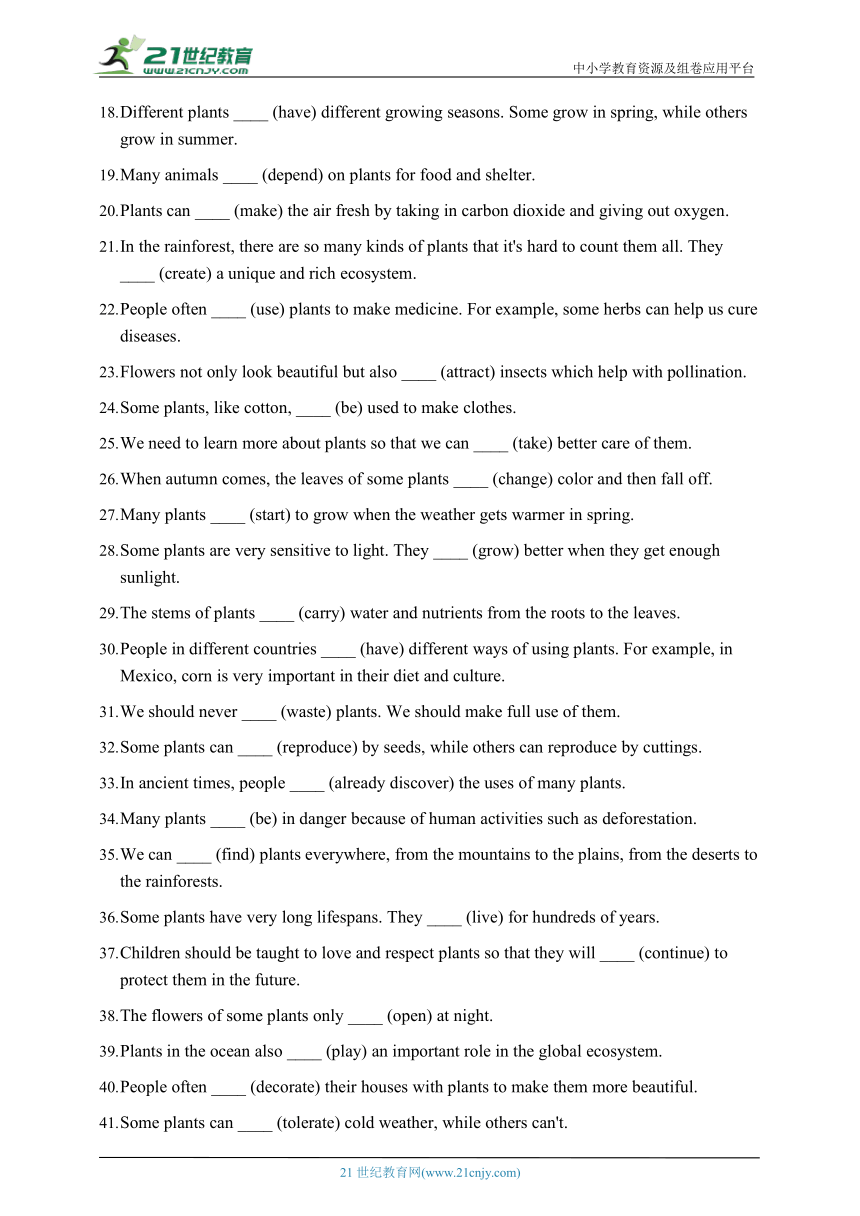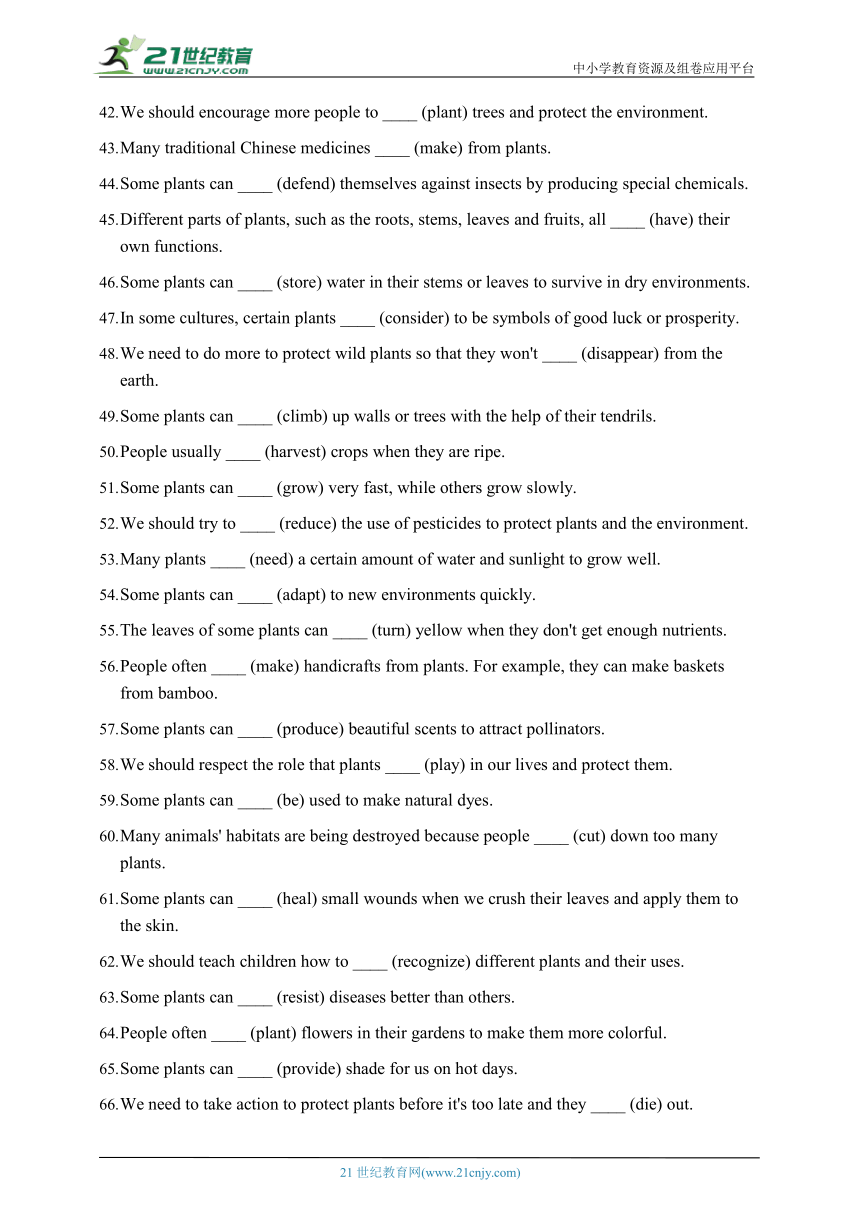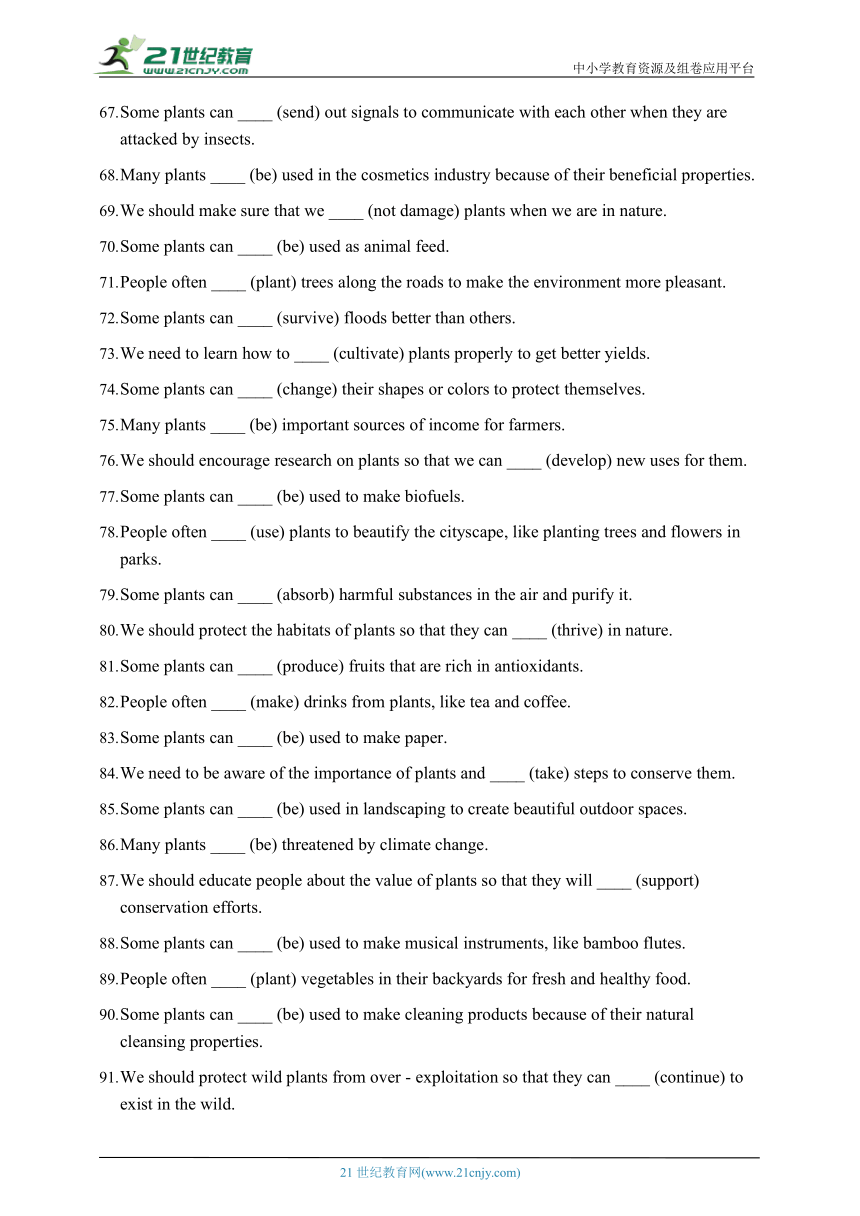Unit5 The power of plants单元语法填空专项训练100题(含答案)2025外研版七年级上册
文档属性
| 名称 | Unit5 The power of plants单元语法填空专项训练100题(含答案)2025外研版七年级上册 |  | |
| 格式 | docx | ||
| 文件大小 | 52.7KB | ||
| 资源类型 | 试卷 | ||
| 版本资源 | 外研版 | ||
| 科目 | 英语 | ||
| 更新时间 | 2025-07-26 15:04:01 | ||
图片预览




文档简介
中小学教育资源及组卷应用平台
2025外研版七年级上册
Unit5 The power of plants单元语法填空专项训练
Plants are very important to our life. They ____ (provide) us with food, oxygen and many other things.
The process of photosynthesis is amazing. Plants ____ (use) sunlight, water and carbon dioxide to make sugar and oxygen.
Every day, workers in the plant's "workshops" ____ (collect) sunlight and carbon dioxide during the day.
There ____ (be) millions of different kinds of plants on the earth.
Without plants, the natural world ____ (be) very different. We couldn't live without them.
Some plants, like bamboo, ____ (have) many uses. We can use it to make furniture, build houses and even eat its shoots.
Tea is a very popular drink. In China, people ____ (drink) tea for thousands of years. It's not only a drink but also a part of the culture.
In the UK, afternoon tea ____ (be) an important part of their daily life. People often enjoy tea with sandwiches and cakes.
Workers in the "Leaf" workshop will ____ (mix) water, carbon dioxide and sunlight to produce sugar and oxygen.
Plants also play a crucial role in the ecosystem. They ____ (help) keep the balance of nature.
Every spring, many people ____ (plant) trees to make our environment more beautiful and greener.
Some plants can ____ (survive) in very harsh conditions, like cacti in the desert.
Many fruits, such as apples and oranges, ____ (be) rich in vitamins and good for our health.
Farmers usually ____ (grow) crops like wheat and rice to feed the population.
The roots of plants ____ (hold) the soil in place and prevent soil erosion.
We should ____ (protect) plants because they are so important to our planet.
Scientists are always studying plants to find out more about how they ____ (work) and how we can make better use of them.
Different plants ____ (have) different growing seasons. Some grow in spring, while others grow in summer.
Many animals ____ (depend) on plants for food and shelter.
Plants can ____ (make) the air fresh by taking in carbon dioxide and giving out oxygen.
In the rainforest, there are so many kinds of plants that it's hard to count them all. They ____ (create) a unique and rich ecosystem.
People often ____ (use) plants to make medicine. For example, some herbs can help us cure diseases.
Flowers not only look beautiful but also ____ (attract) insects which help with pollination.
Some plants, like cotton, ____ (be) used to make clothes.
We need to learn more about plants so that we can ____ (take) better care of them.
When autumn comes, the leaves of some plants ____ (change) color and then fall off.
Many plants ____ (start) to grow when the weather gets warmer in spring.
Some plants are very sensitive to light. They ____ (grow) better when they get enough sunlight.
The stems of plants ____ (carry) water and nutrients from the roots to the leaves.
People in different countries ____ (have) different ways of using plants. For example, in Mexico, corn is very important in their diet and culture.
We should never ____ (waste) plants. We should make full use of them.
Some plants can ____ (reproduce) by seeds, while others can reproduce by cuttings.
In ancient times, people ____ (already discover) the uses of many plants.
Many plants ____ (be) in danger because of human activities such as deforestation.
We can ____ (find) plants everywhere, from the mountains to the plains, from the deserts to the rainforests.
Some plants have very long lifespans. They ____ (live) for hundreds of years.
Children should be taught to love and respect plants so that they will ____ (continue) to protect them in the future.
The flowers of some plants only ____ (open) at night.
Plants in the ocean also ____ (play) an important role in the global ecosystem.
People often ____ (decorate) their houses with plants to make them more beautiful.
Some plants can ____ (tolerate) cold weather, while others can't.
We should encourage more people to ____ (plant) trees and protect the environment.
Many traditional Chinese medicines ____ (make) from plants.
Some plants can ____ (defend) themselves against insects by producing special chemicals.
Different parts of plants, such as the roots, stems, leaves and fruits, all ____ (have) their own functions.
Some plants can ____ (store) water in their stems or leaves to survive in dry environments.
In some cultures, certain plants ____ (consider) to be symbols of good luck or prosperity.
We need to do more to protect wild plants so that they won't ____ (disappear) from the earth.
Some plants can ____ (climb) up walls or trees with the help of their tendrils.
People usually ____ (harvest) crops when they are ripe.
Some plants can ____ (grow) very fast, while others grow slowly.
We should try to ____ (reduce) the use of pesticides to protect plants and the environment.
Many plants ____ (need) a certain amount of water and sunlight to grow well.
Some plants can ____ (adapt) to new environments quickly.
The leaves of some plants can ____ (turn) yellow when they don't get enough nutrients.
People often ____ (make) handicrafts from plants. For example, they can make baskets from bamboo.
Some plants can ____ (produce) beautiful scents to attract pollinators.
We should respect the role that plants ____ (play) in our lives and protect them.
Some plants can ____ (be) used to make natural dyes.
Many animals' habitats are being destroyed because people ____ (cut) down too many plants.
Some plants can ____ (heal) small wounds when we crush their leaves and apply them to the skin.
We should teach children how to ____ (recognize) different plants and their uses.
Some plants can ____ (resist) diseases better than others.
People often ____ (plant) flowers in their gardens to make them more colorful.
Some plants can ____ (provide) shade for us on hot days.
We need to take action to protect plants before it's too late and they ____ (die) out.
Some plants can ____ (send) out signals to communicate with each other when they are attacked by insects.
Many plants ____ (be) used in the cosmetics industry because of their beneficial properties.
We should make sure that we ____ (not damage) plants when we are in nature.
Some plants can ____ (be) used as animal feed.
People often ____ (plant) trees along the roads to make the environment more pleasant.
Some plants can ____ (survive) floods better than others.
We need to learn how to ____ (cultivate) plants properly to get better yields.
Some plants can ____ (change) their shapes or colors to protect themselves.
Many plants ____ (be) important sources of income for farmers.
We should encourage research on plants so that we can ____ (develop) new uses for them.
Some plants can ____ (be) used to make biofuels.
People often ____ (use) plants to beautify the cityscape, like planting trees and flowers in parks.
Some plants can ____ (absorb) harmful substances in the air and purify it.
We should protect the habitats of plants so that they can ____ (thrive) in nature.
Some plants can ____ (produce) fruits that are rich in antioxidants.
People often ____ (make) drinks from plants, like tea and coffee.
Some plants can ____ (be) used to make paper.
We need to be aware of the importance of plants and ____ (take) steps to conserve them.
Some plants can ____ (be) used in landscaping to create beautiful outdoor spaces.
Many plants ____ (be) threatened by climate change.
We should educate people about the value of plants so that they will ____ (support) conservation efforts.
Some plants can ____ (be) used to make musical instruments, like bamboo flutes.
People often ____ (plant) vegetables in their backyards for fresh and healthy food.
Some plants can ____ (be) used to make cleaning products because of their natural cleansing properties.
We should protect wild plants from over - exploitation so that they can ____ (continue) to exist in the wild.
Some plants can ____ (be) used to make dyes for fabrics.
Many plants ____ (be) an important part of traditional festivals in different cultures.
We need to find ways to balance human needs and the protection of plants so that we can ____ (live) in harmony with nature.
Some plants can ____ (be) used to make herbal teas with various health benefits.
People often ____ (plant) trees as a symbol of hope and new beginnings.
Some plants can ____ (be) used to make natural insect repellents.
We should raise public awareness about the importance of plants so that more people will ____ (participate) in plant protection activities.
Some plants can ____ (be) used to make artworks, like pressed flower pictures.
We need to ensure that future generations can also enjoy the benefits of plants by ____ (preserving) them today.
答案解析:
provide:主语plants是复数,且句子描述一般事实,用一般现在时,动词用原形。
use:主语plants是复数,一般现在时,用动词原形,描述植物进行光合作用的一般情况。
collect:主语workers是复数,根据“during the day”可知是一般现在时,用动词原形,符合文中植物光合作用中相关物质收集的表述。
are:there be句型遵循就近原则,后面“millions of different kinds of plants”是复数,所以用are。
would be:此句是虚拟语气,“Without plants”表示假设,没有植物的话,自然世界会很不一样,与现在事实相反,主句用“would+动词原形”。
have:主语bamboo虽为不可数名词,但此处指竹子这类植物,看作复数概念,一般现在时用原形,说明竹子有多种用途。
have drunk:根据“for thousands of years”可知,要用现在完成时,其结构为“have/has+过去分词”,主语people是复数,用have drunk,强调中国人饮茶的动作从过去持续到现在。
is:“afternoon tea”是单数,且是客观事实,一般现在时,用is,说明下午茶在英国日常生活中的重要性。
mix:will后接动词原形,这里表示“Leaf”车间的工人会将水、二氧化碳和阳光混合,符合植物光合作用相关内容。
help:主语plants是复数,一般现在时,用动词原形,阐述植物在生态系统中的作用。
plant:主语people是复数,“Every spring”表明是一般现在时,用原形,说明人们春天种树的常规行为。
survive:can是情态动词,后接动词原形,说明一些植物能在恶劣环境中生存的能力。
are:主语“Many fruits”是复数,一般现在时,用are,介绍水果富含维生素的事实。
grow:主语farmers是复数,一般现在时,用原形,描述农民种植庄稼的日常活动。
hold:主语“roots”是复数,一般现在时,用原形,说明植物根部保持水土的功能。
protect:should是情态动词,后接动词原形,强调我们应该保护植物。
work:how引导的宾语从句中,主语they是复数,一般现在时,用原形,指科学家研究植物的工作原理。
have:主语“Different plants”是复数,一般现在时,用原形,说明不同植物有不同生长季节。
depend:主语“Many animals”是复数,一般现在时,用原形,表明动物依赖植物生存。
make:can是情态动词,后接动词原形,说明植物净化空气的作用。
create:主语“They”指雨林中的植物,是复数,一般现在时,用原形,说明雨林植物创造了独特生态系统。
use:主语people是复数,一般现在时,用原形,说明人们用植物制药的情况。
attract:not only...but also...连接并列谓语,与look并列,用动词原形,说明花吸引昆虫的作用。
are:主语“Some plants”是复数,一般现在时,用are,介绍棉花被用来做衣服的用途。
take:to是不定式符号,后接动词原形,“take better care of”表示更好地照顾植物。
change:“When autumn comes”表明是一般现在时,主语“the leaves”是复数,用原形,说明秋天树叶变色的现象。
start:“when the weather gets warmer in spring”是一般现在时,主语“Many plants”是复数,用原形,说明春天植物开始生长。
grow:情态动词can后接动词原形,说明一些植物对光照的需求。
carry:主语“stems”是复数,一般现在时,用原形,说明植物茎的运输功能。
have:主语“People”是复数,一般现在时,用原形,说明不同国家的人对植物有不同利用方式。
waste:should never后接动词原形,强调不应浪费植物。
reproduce:can后接动词原形,说明植物的繁殖方式。
already discovered:根据“In ancient times”可知,动作发生在过去,对现在有影响,用现在完成时,“people”是复数,用have discovered,说明古代人对植物用途的发现。
are:主语“Many plants”是复数,一般现在时,用are,说明很多植物因人类活动处于危险中。
find:can后接动词原形,说明植物在自然界中分布广泛。
live:情态动词can后接动词原形,说明一些植物寿命长。
continue:will后接动词原形,说明要教导孩子保护植物,让他们将来继续保护。
open:情态动词can后接动词原形,说明一些花的开放特点。
play:主语“Plants”是复数,一般现在时,用原形,说明海洋植物在生态系统中的作用。
decorate:主语people是复数,一般现在时,用原形,说明人们用植物装饰房屋。
tolerate:can后接动词原形,说明一些植物耐受寒冷天气的能力。
plant:encourage sb. to do sth.是固定搭配,用动词原形,鼓励人们种树。
are made:“Many traditional Chinese medicines”与make是被动关系,用被动语态,且是一般现在时,主语是复数,用are made,说明中药与植物的关系。
defend:can后接动词原形,说明植物的自我保护能力。
have:主语“Different parts of plants”是复数,一般现在时,用原形,说明植物不同部位有不同功能。
store:can后接动词原形,说明一些植物储存水分的能力。
are considered:“certain plants”与consider是被动关系,一般现在时,主语复数,用are considered,说明一些植物在文化中的象征意义。
disappear:won't是will not的缩写,后接动词原形,说明要保护野生植物防止其消失。
climb:can后接动词原形,说明一些植物的攀爬特性。
harvest:主语people是复数,一般现在时,用原形,说明人们收获庄稼的时间。
grow:can后接动词原形,说明植物生长速度有差异。
reduce:try to do sth.是固定用法,用动词原形,强调要减少农药使用保护植物。
need:主语“Many plants”是复数,一般现在时,用原形,说明植物生长对水和阳光的需求。
adapt:can后接动词原形,说明一些植物适应环境的能力。
turn:情态动词can后接动词原形,说明植物叶子缺营养时的变化。
make:主语people是复数,一般现在时,用原形,说明人们用植物制作手工艺品。
produce:can后接动词原形,说明一些植物产生香味吸引传粉者。
play:主语“plants”是复数,一般现在时,用原形,说明要尊重植物的作用。
be used:can后接动词原形,此处是被动语态,说明植物可被用来制作天然染料。
cut:主语people是复数,一般现在时,用原形,说明人类砍伐植物对动物栖息地的破坏。
heal:can后接动词原形,说明一些植物叶子的药用功能。
recognize:how to do sth.是固定结构,用动词原形,教导孩子识别植物。
resist:can后接动词原形,说明一些植物的抗病能力。
plant:主语people是复数,一般现在时,用原形,说明人们在花园种花。
provide:can后接动词原形,说明植物在炎热天气提供阴凉的作用。
die:will后接动词原形,说明要保护植物防止其灭绝。
send:can后接动词原形,说明一些植物相互交流的方式。
are:“Many plants”与use是被动关系,一般现在时,主语复数,用are,说明植物在化妆品行业的应用。
not damage:should后接动词原形,否定式在动词前加not,强调要保护植物不破坏。
be used:can后接动词原形,此处是被动语态,说明植物可被用作动物饲料。
plant:主语people是复数,一般现在时,用原形,说明人们在路边种树的行为。
survive:can后接动词原形,说明一些植物耐洪涝的能力。
cultivate:learn to do sth.是固定搭配,用动词原形,说明要学习正确种植植物。
change:can后接动词原形,说明一些植物的自我保护形态变化。
are:主语“Many plants”是复数,一般现在时,用are,说明植物对农民的经济重要性。
develop:to是不定式符号,后接动词原形,说明要研发植物新用途。
be used:can后接动词原形,此处是被动语态,说明植物可被用来制作生物燃料。
use:主语people是复数,一般现在时,用原形,说明人们用植物美化城市景观。
absorb:can后接动词原形,说明植物吸收有害物质净化空气的作用。
thrive:can后接动词原形,说明要保护植物栖息地让其茁壮成长。
produce:can后接动词原形,说明一些植物产生富含抗氧化物质果实的能力。
make:主语people是复数,一般现在时,用原形,说明人们用植物制作饮品。
be used:can后接动词原形,此处是被动语态,说明植物可被用来造纸。
take:and连接并列结构,与be aware of并列,to后接动词原形,说明要采取措施保护植物。
be used:can后接动词原形,此处是被动语态,说明植物可用于景观美化。
are:主语“Many plants”是复数,一般现在时,用are,说明植物受气候变化威胁。
support:will后接动词原形,说明要教育人们支持植物保护工作。
be used:can后接动词原形,此处是被动语态,说明植物可被用来制作乐器。
plant:主语people是复数,一般现在时,用原形,说明人们在后院种蔬菜。
be used:can后接动词原形,此处是被动语态,说明植物可被用来制作清洁产品。
continue:will后接动词原形,说明要保护野生植物使其继续存在。
be used:can后接动词原形,此处是被动语态,说明植物可被用来制作染料。
are:主语“Many plants”是复数,一般现在时,用are,说明植物在传统节日中的重要性。
live:to是不定式符号,后接动词原形,说明要与自然和谐共处。
be used:can后接动词原形,此处是被动语态,说明植物可被用来制作草药茶。
plant:主语people是复数,一般现在时,用原形,说明人们种树的象征意义。
be used:can后接动词原形,此处是被动语态,说明植物可被用来制作天然驱虫剂。
participate:will后接动词原形,说明要让更多人参与植物保护活动。
be used:can后接动词原形,此处是被动语态,说明植物可被用来制作艺术品。
preserving:by是介词,后接动名词,说明要通过保护植物让后代享受其益处。
21世纪教育网 www.21cnjy.com 精品试卷·第 2 页 (共 2 页)
21世纪教育网(www.21cnjy.com)
2025外研版七年级上册
Unit5 The power of plants单元语法填空专项训练
Plants are very important to our life. They ____ (provide) us with food, oxygen and many other things.
The process of photosynthesis is amazing. Plants ____ (use) sunlight, water and carbon dioxide to make sugar and oxygen.
Every day, workers in the plant's "workshops" ____ (collect) sunlight and carbon dioxide during the day.
There ____ (be) millions of different kinds of plants on the earth.
Without plants, the natural world ____ (be) very different. We couldn't live without them.
Some plants, like bamboo, ____ (have) many uses. We can use it to make furniture, build houses and even eat its shoots.
Tea is a very popular drink. In China, people ____ (drink) tea for thousands of years. It's not only a drink but also a part of the culture.
In the UK, afternoon tea ____ (be) an important part of their daily life. People often enjoy tea with sandwiches and cakes.
Workers in the "Leaf" workshop will ____ (mix) water, carbon dioxide and sunlight to produce sugar and oxygen.
Plants also play a crucial role in the ecosystem. They ____ (help) keep the balance of nature.
Every spring, many people ____ (plant) trees to make our environment more beautiful and greener.
Some plants can ____ (survive) in very harsh conditions, like cacti in the desert.
Many fruits, such as apples and oranges, ____ (be) rich in vitamins and good for our health.
Farmers usually ____ (grow) crops like wheat and rice to feed the population.
The roots of plants ____ (hold) the soil in place and prevent soil erosion.
We should ____ (protect) plants because they are so important to our planet.
Scientists are always studying plants to find out more about how they ____ (work) and how we can make better use of them.
Different plants ____ (have) different growing seasons. Some grow in spring, while others grow in summer.
Many animals ____ (depend) on plants for food and shelter.
Plants can ____ (make) the air fresh by taking in carbon dioxide and giving out oxygen.
In the rainforest, there are so many kinds of plants that it's hard to count them all. They ____ (create) a unique and rich ecosystem.
People often ____ (use) plants to make medicine. For example, some herbs can help us cure diseases.
Flowers not only look beautiful but also ____ (attract) insects which help with pollination.
Some plants, like cotton, ____ (be) used to make clothes.
We need to learn more about plants so that we can ____ (take) better care of them.
When autumn comes, the leaves of some plants ____ (change) color and then fall off.
Many plants ____ (start) to grow when the weather gets warmer in spring.
Some plants are very sensitive to light. They ____ (grow) better when they get enough sunlight.
The stems of plants ____ (carry) water and nutrients from the roots to the leaves.
People in different countries ____ (have) different ways of using plants. For example, in Mexico, corn is very important in their diet and culture.
We should never ____ (waste) plants. We should make full use of them.
Some plants can ____ (reproduce) by seeds, while others can reproduce by cuttings.
In ancient times, people ____ (already discover) the uses of many plants.
Many plants ____ (be) in danger because of human activities such as deforestation.
We can ____ (find) plants everywhere, from the mountains to the plains, from the deserts to the rainforests.
Some plants have very long lifespans. They ____ (live) for hundreds of years.
Children should be taught to love and respect plants so that they will ____ (continue) to protect them in the future.
The flowers of some plants only ____ (open) at night.
Plants in the ocean also ____ (play) an important role in the global ecosystem.
People often ____ (decorate) their houses with plants to make them more beautiful.
Some plants can ____ (tolerate) cold weather, while others can't.
We should encourage more people to ____ (plant) trees and protect the environment.
Many traditional Chinese medicines ____ (make) from plants.
Some plants can ____ (defend) themselves against insects by producing special chemicals.
Different parts of plants, such as the roots, stems, leaves and fruits, all ____ (have) their own functions.
Some plants can ____ (store) water in their stems or leaves to survive in dry environments.
In some cultures, certain plants ____ (consider) to be symbols of good luck or prosperity.
We need to do more to protect wild plants so that they won't ____ (disappear) from the earth.
Some plants can ____ (climb) up walls or trees with the help of their tendrils.
People usually ____ (harvest) crops when they are ripe.
Some plants can ____ (grow) very fast, while others grow slowly.
We should try to ____ (reduce) the use of pesticides to protect plants and the environment.
Many plants ____ (need) a certain amount of water and sunlight to grow well.
Some plants can ____ (adapt) to new environments quickly.
The leaves of some plants can ____ (turn) yellow when they don't get enough nutrients.
People often ____ (make) handicrafts from plants. For example, they can make baskets from bamboo.
Some plants can ____ (produce) beautiful scents to attract pollinators.
We should respect the role that plants ____ (play) in our lives and protect them.
Some plants can ____ (be) used to make natural dyes.
Many animals' habitats are being destroyed because people ____ (cut) down too many plants.
Some plants can ____ (heal) small wounds when we crush their leaves and apply them to the skin.
We should teach children how to ____ (recognize) different plants and their uses.
Some plants can ____ (resist) diseases better than others.
People often ____ (plant) flowers in their gardens to make them more colorful.
Some plants can ____ (provide) shade for us on hot days.
We need to take action to protect plants before it's too late and they ____ (die) out.
Some plants can ____ (send) out signals to communicate with each other when they are attacked by insects.
Many plants ____ (be) used in the cosmetics industry because of their beneficial properties.
We should make sure that we ____ (not damage) plants when we are in nature.
Some plants can ____ (be) used as animal feed.
People often ____ (plant) trees along the roads to make the environment more pleasant.
Some plants can ____ (survive) floods better than others.
We need to learn how to ____ (cultivate) plants properly to get better yields.
Some plants can ____ (change) their shapes or colors to protect themselves.
Many plants ____ (be) important sources of income for farmers.
We should encourage research on plants so that we can ____ (develop) new uses for them.
Some plants can ____ (be) used to make biofuels.
People often ____ (use) plants to beautify the cityscape, like planting trees and flowers in parks.
Some plants can ____ (absorb) harmful substances in the air and purify it.
We should protect the habitats of plants so that they can ____ (thrive) in nature.
Some plants can ____ (produce) fruits that are rich in antioxidants.
People often ____ (make) drinks from plants, like tea and coffee.
Some plants can ____ (be) used to make paper.
We need to be aware of the importance of plants and ____ (take) steps to conserve them.
Some plants can ____ (be) used in landscaping to create beautiful outdoor spaces.
Many plants ____ (be) threatened by climate change.
We should educate people about the value of plants so that they will ____ (support) conservation efforts.
Some plants can ____ (be) used to make musical instruments, like bamboo flutes.
People often ____ (plant) vegetables in their backyards for fresh and healthy food.
Some plants can ____ (be) used to make cleaning products because of their natural cleansing properties.
We should protect wild plants from over - exploitation so that they can ____ (continue) to exist in the wild.
Some plants can ____ (be) used to make dyes for fabrics.
Many plants ____ (be) an important part of traditional festivals in different cultures.
We need to find ways to balance human needs and the protection of plants so that we can ____ (live) in harmony with nature.
Some plants can ____ (be) used to make herbal teas with various health benefits.
People often ____ (plant) trees as a symbol of hope and new beginnings.
Some plants can ____ (be) used to make natural insect repellents.
We should raise public awareness about the importance of plants so that more people will ____ (participate) in plant protection activities.
Some plants can ____ (be) used to make artworks, like pressed flower pictures.
We need to ensure that future generations can also enjoy the benefits of plants by ____ (preserving) them today.
答案解析:
provide:主语plants是复数,且句子描述一般事实,用一般现在时,动词用原形。
use:主语plants是复数,一般现在时,用动词原形,描述植物进行光合作用的一般情况。
collect:主语workers是复数,根据“during the day”可知是一般现在时,用动词原形,符合文中植物光合作用中相关物质收集的表述。
are:there be句型遵循就近原则,后面“millions of different kinds of plants”是复数,所以用are。
would be:此句是虚拟语气,“Without plants”表示假设,没有植物的话,自然世界会很不一样,与现在事实相反,主句用“would+动词原形”。
have:主语bamboo虽为不可数名词,但此处指竹子这类植物,看作复数概念,一般现在时用原形,说明竹子有多种用途。
have drunk:根据“for thousands of years”可知,要用现在完成时,其结构为“have/has+过去分词”,主语people是复数,用have drunk,强调中国人饮茶的动作从过去持续到现在。
is:“afternoon tea”是单数,且是客观事实,一般现在时,用is,说明下午茶在英国日常生活中的重要性。
mix:will后接动词原形,这里表示“Leaf”车间的工人会将水、二氧化碳和阳光混合,符合植物光合作用相关内容。
help:主语plants是复数,一般现在时,用动词原形,阐述植物在生态系统中的作用。
plant:主语people是复数,“Every spring”表明是一般现在时,用原形,说明人们春天种树的常规行为。
survive:can是情态动词,后接动词原形,说明一些植物能在恶劣环境中生存的能力。
are:主语“Many fruits”是复数,一般现在时,用are,介绍水果富含维生素的事实。
grow:主语farmers是复数,一般现在时,用原形,描述农民种植庄稼的日常活动。
hold:主语“roots”是复数,一般现在时,用原形,说明植物根部保持水土的功能。
protect:should是情态动词,后接动词原形,强调我们应该保护植物。
work:how引导的宾语从句中,主语they是复数,一般现在时,用原形,指科学家研究植物的工作原理。
have:主语“Different plants”是复数,一般现在时,用原形,说明不同植物有不同生长季节。
depend:主语“Many animals”是复数,一般现在时,用原形,表明动物依赖植物生存。
make:can是情态动词,后接动词原形,说明植物净化空气的作用。
create:主语“They”指雨林中的植物,是复数,一般现在时,用原形,说明雨林植物创造了独特生态系统。
use:主语people是复数,一般现在时,用原形,说明人们用植物制药的情况。
attract:not only...but also...连接并列谓语,与look并列,用动词原形,说明花吸引昆虫的作用。
are:主语“Some plants”是复数,一般现在时,用are,介绍棉花被用来做衣服的用途。
take:to是不定式符号,后接动词原形,“take better care of”表示更好地照顾植物。
change:“When autumn comes”表明是一般现在时,主语“the leaves”是复数,用原形,说明秋天树叶变色的现象。
start:“when the weather gets warmer in spring”是一般现在时,主语“Many plants”是复数,用原形,说明春天植物开始生长。
grow:情态动词can后接动词原形,说明一些植物对光照的需求。
carry:主语“stems”是复数,一般现在时,用原形,说明植物茎的运输功能。
have:主语“People”是复数,一般现在时,用原形,说明不同国家的人对植物有不同利用方式。
waste:should never后接动词原形,强调不应浪费植物。
reproduce:can后接动词原形,说明植物的繁殖方式。
already discovered:根据“In ancient times”可知,动作发生在过去,对现在有影响,用现在完成时,“people”是复数,用have discovered,说明古代人对植物用途的发现。
are:主语“Many plants”是复数,一般现在时,用are,说明很多植物因人类活动处于危险中。
find:can后接动词原形,说明植物在自然界中分布广泛。
live:情态动词can后接动词原形,说明一些植物寿命长。
continue:will后接动词原形,说明要教导孩子保护植物,让他们将来继续保护。
open:情态动词can后接动词原形,说明一些花的开放特点。
play:主语“Plants”是复数,一般现在时,用原形,说明海洋植物在生态系统中的作用。
decorate:主语people是复数,一般现在时,用原形,说明人们用植物装饰房屋。
tolerate:can后接动词原形,说明一些植物耐受寒冷天气的能力。
plant:encourage sb. to do sth.是固定搭配,用动词原形,鼓励人们种树。
are made:“Many traditional Chinese medicines”与make是被动关系,用被动语态,且是一般现在时,主语是复数,用are made,说明中药与植物的关系。
defend:can后接动词原形,说明植物的自我保护能力。
have:主语“Different parts of plants”是复数,一般现在时,用原形,说明植物不同部位有不同功能。
store:can后接动词原形,说明一些植物储存水分的能力。
are considered:“certain plants”与consider是被动关系,一般现在时,主语复数,用are considered,说明一些植物在文化中的象征意义。
disappear:won't是will not的缩写,后接动词原形,说明要保护野生植物防止其消失。
climb:can后接动词原形,说明一些植物的攀爬特性。
harvest:主语people是复数,一般现在时,用原形,说明人们收获庄稼的时间。
grow:can后接动词原形,说明植物生长速度有差异。
reduce:try to do sth.是固定用法,用动词原形,强调要减少农药使用保护植物。
need:主语“Many plants”是复数,一般现在时,用原形,说明植物生长对水和阳光的需求。
adapt:can后接动词原形,说明一些植物适应环境的能力。
turn:情态动词can后接动词原形,说明植物叶子缺营养时的变化。
make:主语people是复数,一般现在时,用原形,说明人们用植物制作手工艺品。
produce:can后接动词原形,说明一些植物产生香味吸引传粉者。
play:主语“plants”是复数,一般现在时,用原形,说明要尊重植物的作用。
be used:can后接动词原形,此处是被动语态,说明植物可被用来制作天然染料。
cut:主语people是复数,一般现在时,用原形,说明人类砍伐植物对动物栖息地的破坏。
heal:can后接动词原形,说明一些植物叶子的药用功能。
recognize:how to do sth.是固定结构,用动词原形,教导孩子识别植物。
resist:can后接动词原形,说明一些植物的抗病能力。
plant:主语people是复数,一般现在时,用原形,说明人们在花园种花。
provide:can后接动词原形,说明植物在炎热天气提供阴凉的作用。
die:will后接动词原形,说明要保护植物防止其灭绝。
send:can后接动词原形,说明一些植物相互交流的方式。
are:“Many plants”与use是被动关系,一般现在时,主语复数,用are,说明植物在化妆品行业的应用。
not damage:should后接动词原形,否定式在动词前加not,强调要保护植物不破坏。
be used:can后接动词原形,此处是被动语态,说明植物可被用作动物饲料。
plant:主语people是复数,一般现在时,用原形,说明人们在路边种树的行为。
survive:can后接动词原形,说明一些植物耐洪涝的能力。
cultivate:learn to do sth.是固定搭配,用动词原形,说明要学习正确种植植物。
change:can后接动词原形,说明一些植物的自我保护形态变化。
are:主语“Many plants”是复数,一般现在时,用are,说明植物对农民的经济重要性。
develop:to是不定式符号,后接动词原形,说明要研发植物新用途。
be used:can后接动词原形,此处是被动语态,说明植物可被用来制作生物燃料。
use:主语people是复数,一般现在时,用原形,说明人们用植物美化城市景观。
absorb:can后接动词原形,说明植物吸收有害物质净化空气的作用。
thrive:can后接动词原形,说明要保护植物栖息地让其茁壮成长。
produce:can后接动词原形,说明一些植物产生富含抗氧化物质果实的能力。
make:主语people是复数,一般现在时,用原形,说明人们用植物制作饮品。
be used:can后接动词原形,此处是被动语态,说明植物可被用来造纸。
take:and连接并列结构,与be aware of并列,to后接动词原形,说明要采取措施保护植物。
be used:can后接动词原形,此处是被动语态,说明植物可用于景观美化。
are:主语“Many plants”是复数,一般现在时,用are,说明植物受气候变化威胁。
support:will后接动词原形,说明要教育人们支持植物保护工作。
be used:can后接动词原形,此处是被动语态,说明植物可被用来制作乐器。
plant:主语people是复数,一般现在时,用原形,说明人们在后院种蔬菜。
be used:can后接动词原形,此处是被动语态,说明植物可被用来制作清洁产品。
continue:will后接动词原形,说明要保护野生植物使其继续存在。
be used:can后接动词原形,此处是被动语态,说明植物可被用来制作染料。
are:主语“Many plants”是复数,一般现在时,用are,说明植物在传统节日中的重要性。
live:to是不定式符号,后接动词原形,说明要与自然和谐共处。
be used:can后接动词原形,此处是被动语态,说明植物可被用来制作草药茶。
plant:主语people是复数,一般现在时,用原形,说明人们种树的象征意义。
be used:can后接动词原形,此处是被动语态,说明植物可被用来制作天然驱虫剂。
participate:will后接动词原形,说明要让更多人参与植物保护活动。
be used:can后接动词原形,此处是被动语态,说明植物可被用来制作艺术品。
preserving:by是介词,后接动名词,说明要通过保护植物让后代享受其益处。
21世纪教育网 www.21cnjy.com 精品试卷·第 2 页 (共 2 页)
21世纪教育网(www.21cnjy.com)
同课章节目录
